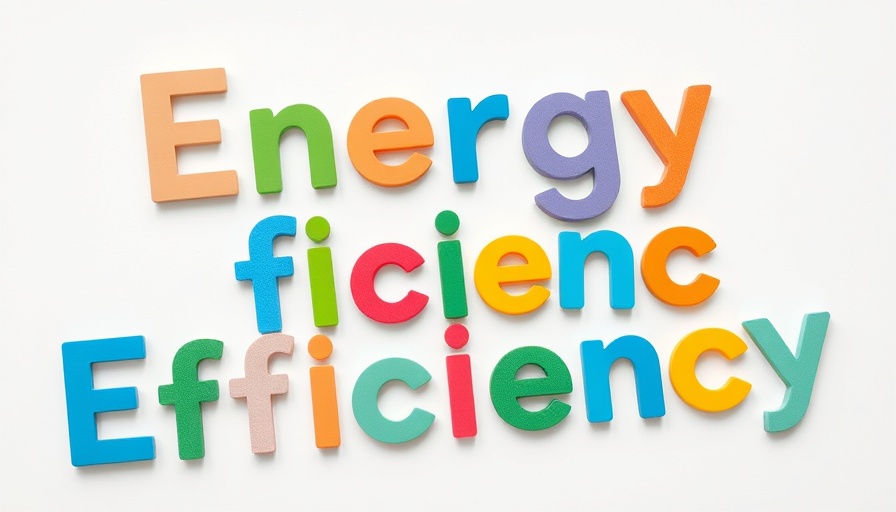
Understanding the Hidden Costs of Inefficiency
For many business owners, the concept of inefficiency may seem abstract—a mere hindrance to smooth operations. However, as the saying goes, 'out of sight, out of mind.' The pervasive issue of inefficiency isn't limited to visible delays or workflow bottlenecks; it subtly siphons off profits without ever being noticed. Think of inefficiency like a slow, unnoticeable leak. When left unaddressed, it accumulates, leading to significant financial repercussions over time.
Energy Waste: An Unseen Predator
Energy costs represent one of the most substantial operating expenses that companies face. While necessary for productivity, wasted energy is wholly avoidable. The small, everyday inefficiencies—such as leaving lights on in empty offices or using outdated machines that consume excessive power—can pile up to hundreds or even thousands of wasted dollars.
Consider this: modern LED lighting, while slightly more expensive initially, lasts longer and uses less energy than traditional bulbs. By switching light sources, a business can significantly reduce its electric bill. The key takeaway here is simple yet often overlooked: managing energy resources is essential to maintaining and even increasing profit margins.
Beyond Utility Bills: The Ripple Effects of Inefficiency
Inefficiency isn’t merely reflected in what you pay for utilities. It pervades an organization’s operational framework. Outdated machinery, for example, can incur higher maintenance costs, cause productivity losses due to breakdowns, and create frustrating experiences for employees. A computer that freezes frequently not only costs extra for repairs but also drains time as employees are left waiting.
Furthermore, temperature control inefficiencies in the workplace can lead to discomfort, resulting in reduced morale and productivity. Thus, the price of energy mismanagement extends far beyond the utility bill; it permeates various aspects of business operations, creating a compounded financial burden.
Implementing Effective Energy Solutions
The silver lining in addressing inefficiencies is that many energy-efficient solutions are available that can pay for themselves relatively quickly. For instance, transitioning to modern HVAC systems and investing in intelligent energy management tools can lead to immediate cost reductions. Setting up a schedule to turn off lights and machines after hours is a simple yet impactful step.
Training employees to be mindful of energy usage reinforces a culture of responsibility and contributes significantly to ameliorating inefficiencies. Small habits, like unplugging devices that aren’t in use, eventually accumulate into notable savings, fostering a communal effort toward sustainability and efficiency.
Solar Energy: A Game-Changer in Cost Management
However, while measures like upgrading equipment and enhancing employee training are essential, businesses should also consider rethinking their energy source. Solar energy has emerged as a formidable solution not only to combat inefficiencies but also to stabilize costs against unpredictable fossil fuel market fluctuations. With solar panels, businesses can harness free energy from the sun. Once the initial investment is made, the long-term benefits are substantial, allowing for significant operational cost reductions.
Many companies have already begun leveraging solar energy, leading not only to reduced energy costs but also to a sustainable business model attracting eco-conscious customers. Notably, investing in renewable energy sources aligns with the collective global movement toward sustainability, making it a conscientious choice for modern businesses.
The Human Element: Building a Culture of Efficiency
While equipment upgrades and optimizing energy sources are critical steps toward addressing inefficiencies, the human element cannot be understated. Employees are the heartbeat of any organization, and promoting a culture of efficiency requires collective participation. By encouraging staff to adopt energy-saving habits and fostering awareness about the financial impact of inefficiency, businesses can create not just a functional workspace but a more productive, fulfilled workforce.
Moreover, recognizing and rewarding contributions to energy-saving initiatives can enhance employee engagement and reflect positively on company culture. Effective change doesn't solely arise from management's directives; it flourishes in an environment where everyone takes ownership of their role in enhancing productivity.
Conclusion: The Time to Act is Now
In conclusion, inefficiency represents a silent threat to profitability that every business owner must address. From energy waste to operational lag, the costs can accumulate remarkably fast, but fortunately, they can also be reversed. By investing in energy-efficient solutions and instilling a culture of responsibility among employees, businesses can capitalize on greater profits and sustainability.
Consider evaluating your current energy use and explore energy-efficient solutions that can transform the landscape of your operational costs. Remember, the steps you take today to combat inefficiency can pave the way for a more profitable and sustainable tomorrow.
 Add Row
Add Row  Add
Add 




Write A Comment